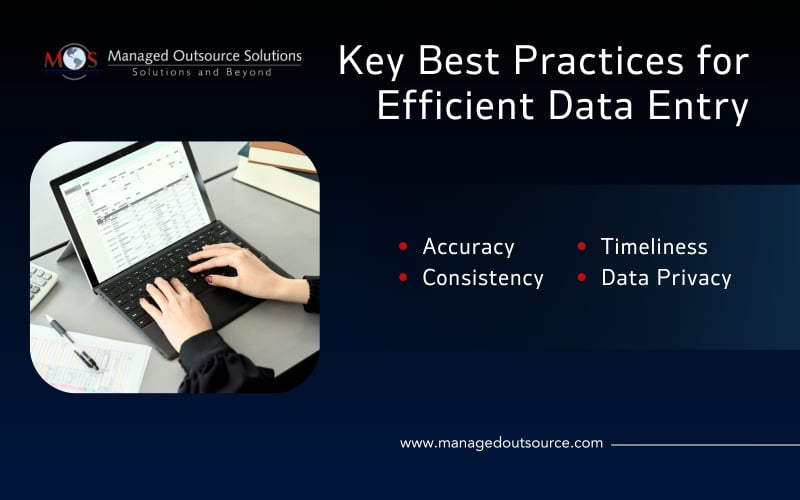A wide range of industries relies on market research to gather crucial information about target audiences, competitors, and market opportunities. The data collected includes demographics, psychographics, behavioral insights, market trends, and customer feedback. The collected data must be accurately converted into a digital format for effective analysis and reporting. Many companies choose to outsource this voluminous and meticulous task to ensure precision and efficiency. Market research data entry services play a vital role in organizing and compiling this data into a structured system, making it readily accessible for analysis by market researchers and data analysts.
By analyzing this data, businesses can gain a deeper understanding of their target audience and the competitive landscape, enabling them to make informed decisions, enhance products and services, ad gain a competitive edge. To understand why precision matters in data entry for market research, let’s first see what the process involves.
Market Research Data Entry Process
The data entry process involves many steps and precision is essential to achieve accurate results and insights.
Pre-data Entry
The following processes must be completed before entering market research data:
- Data Collection: Collecting information through surveys, questionnaires, focus groups/Interviews, and recording of observations. Responses could be in text format, transcripts of audio/video recordings or observations from physical environments or website usage.
- Data Cleansing: Cleaning and organizing the information, including checking for incomplete responses, correcting formatting issues, removing duplicates, and standardizing date formats or measurement units.
- Data segmentation: Grouping the information into categories such as demographics, consumer behavior or response types (positive/negative).
- Coding: For easier analysis, coding of all qualitative data (e.g., text from open-ended questions) into predefined categories.
Data Entry
Inputting of data is done in different ways:
- Manual: Manually entering data from paper forms or physical documents into spreadsheets or databases. This can be time-consuming and prone to human error, so it’s important to be meticulous.
- Automated: Automatically transferring information collected from online surveys or digital forms is into a database or Excel spreadsheet. This reduces human error and speeds up the process.
- OCR (Optical Character Recognition): Using OCR software to scan and convert the physical text in paper forms or handwritten notes into digital format.
- Data Capture Tools: Leveraging specialized tools (such as SurveyMonkey, or Google Forms) to automate data entry for structured surveys, and export it in formats like CSV or Excel for analysis
Data Validation and Quality Control
- Validation checks: Cross-checking entered data to ensure accuracy. This can include checking for outliers, ensuring that numerical values fall within expected ranges, and verifying that the data matches the required format or structure.
- Consistency checks: Ensuring that the entered data aligns with other fields (e.g., ensuring dates are consistent).
- Quality control: Double checking all entries using automated scripts to find discrepancies, and compare them against the original source material to prevent errors.
Data Storage
This step involves storing the data in a way to make it easier to use, retrieve, manipulate, and analyze later. For larger datasets, the data may be entered into a database management system (such as SQL, MySQL, or cloud-based systems). Smaller datasets might be inputted into spreadsheet tools (Excel, Google Sheets).
After inputting and validation is complete, the data is exported into a format suitable for analysis, such as CSV, Excel, or directly into analytical software such as SPSS, R, or Python. Market researchers or analysts can now use the clean data to generate reports, including trend analysis, segmentation analysis, and customer insights.
Why Precision Matters
Market research data is used to take critical business decisions. Accurate market research data entry is essential because it has a direct impact on the reliability of the research outcomes. Any errors when inputting information can lead to faulty insights, erroneous strategies, and ultimately, poor outcomes for companies that use this information. Common errors that can occur when entering data manually include:
- Transcription errors: Typos, duplicated information, or omitted information
- Transposition errors: Swapped numbers or letters
- Formatting and unit errors: Entering data in the wrong style for the dataset, such as entering a date as “01-01-2023” instead of “01/01/2023”
- Source errors: Entering out-of-date or duplicated data
- Misinterpretation: Misreading or misunderstanding data, such as confusing a letter “O” with the number “0
As an example, consider a market research project that aims to understand consumer preferences for a new snack. The company collects survey data from thousands of respondents, asking questions about flavor preferences, purchasing habits, and pricing aspects. If there are errors during the data entry process, such as listing ‘onion’ as the preferred flavor instead of ‘cheese’ in a significant number of entries, the company might conclude that the onion flavor is more popular than it actually is. If this causes analytical errors and leads them to launch an onion-flavored product, they might potentially miss out on actual demand and lose market share.
In this case, lack of precision in data entry could lead to:
- Misunderstanding what consumers want.
- Wasting money on a product that doesn’t attract buyers.
- Losing chances to take advantage of real consumer preferences.
This highlights that precision in data entry is not just a best practice but a necessity for actionable, reliable insights.
Implementing Best Practices
- Accuracy: Ensure that data is entered as accurately as possible to avoid skewing analysis and conclusions.
- Consistency: Standardize the format and terminology used to minimize confusion or errors during analysis.
- Timeliness: Data entry should be done promptly so that it doesn’t delay the analysis and reporting phases of the research process.
- Data privacy: Market research often involves collecting sensitive information, so it’s crucial to adhere to privacy regulations (e.g., GDPR, HIPAA) when handling personal data.
By following these steps and best practices, market researchers can ensure that data entry is done efficiently and accurately, leading to high-quality analysis and actionable insights.
Outsource Data Entry, Ensure Precision
Outsourcing the data entry task can ensure highly accurate, quick data inputting and processing. A data entry company that employs experienced professionals can ensure data accuracy and reliability for high-volume tasks. These experts are trained to handle data entry efficiently, minimizing errors using validation, stringent quality checks and audits, ensuring high standards of quality. Outsourcing also results in faster data processing, allowing companies to focus on analysis and use information promptly to develop effective marketing strategies.
Make sure your data leads to the right decisions with our data entry services!





